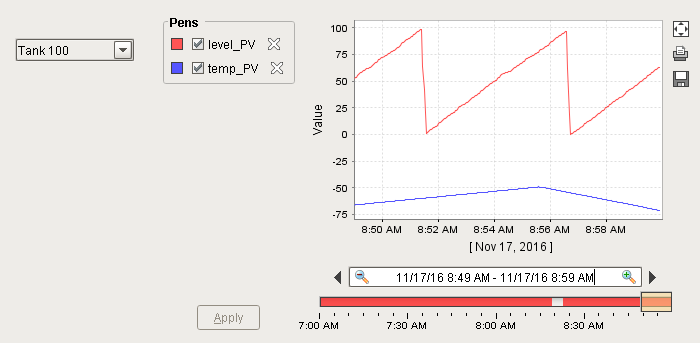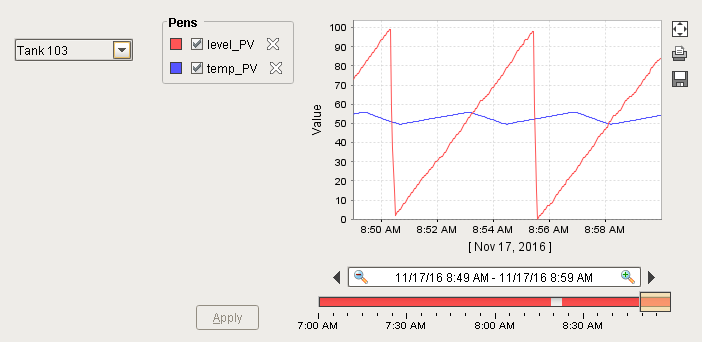Indirect Easy Chart
Configuring an Indirect Easy Chart
To learn more, go to the Tag and Set up Tags to Log pages. The examples below use OPC tags from the Generic Simulator driver, but Memory, Expression, and Query Tags can be used instead.
It is possible for the Easy Chart component to be indirect and point to a set of Historical Tags based on any parameter using the Cell Update Binding type. In this example, suppose you have a small tank farm consisting of Tank 100 through Tank 105. Every tank is identical and uses the same Tags. Each tank has a level_PV and temp_PV Tag which are set to log to the Historian.
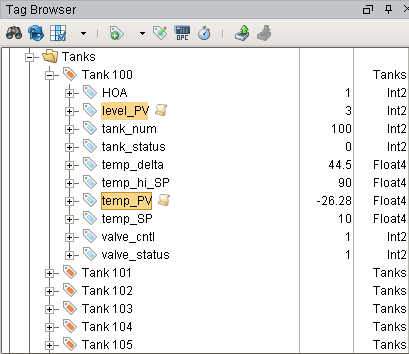
Using an Indirect Easy Chart is a good way to see the history of these Tags for each tank in the tank farm. An easy way to do this is, is by using a dropdown list where an operator can select various tanks to see the Tag history and have the data change dynamically as you select different tanks. Let's give it a try!
In the Designer, drag an Easy Chart component into your workspace. Drag the 'level_PV' and 'temp_PV' Tags from the Tag Browser to the Easy Chart to see the history of these two Tags for Tank 100.

In Design Mode, drag a Dropdown component to your workspace. Using a Dropdown list will make it convenient for the operator to select a tank and see the history of the level_PV and temp_PV Tags for that tank. Double click on the Dropdown component and enter the Values and Labels for all the tanks in your tank farm. Click OK.
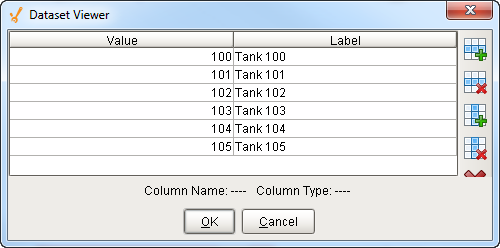
In Preview Mode, click the dropdown list to see the complete list of tanks in your Tank Farm that you just entered.
Go back to Design Mode, right click on your Easy Chart, and scroll down to Customizers > Easy Chart Customizer. You'll notice that the Tag Paths are pointing directly to Tank 100. The only difference between Tank 100 and all the tanks in the tank farm is the tank number (i.e., 101, 102, 103, etc.,). You can manually point to a different Tag Path by replacing ‘100’ in the Tag Path with a different tank number such as ‘101,’ but this defeats the purpose. You want the Tag Paths to change dynamically when you select various tanks. Press OK.
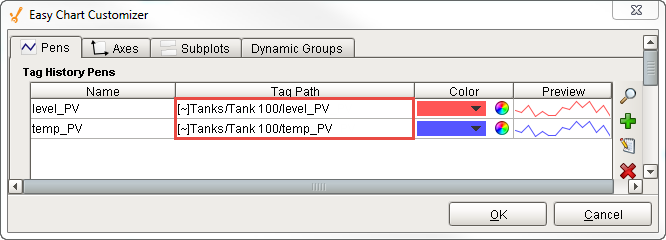
The Easy Chart component has a property called Tag Pens which stores all the configuration information that you have in the Easy Chart about your pens. In the Property Editor, click on the dataset icon to view the information for your Tag Pens. The dataset contains two rows, one for each Tag. The second column is the Tag Path that you want to change dynamically. Press OK.

In order to change an individual cell of a dataset, you can bind a dataset to a Cell Update Binding type. In a Cell Update Binding, you can select one or more cells and dynamically bind them to a property or to a Tag that you have in your system.
To change both Tag Paths in Tank 100, level_PV and temp_PV, use the following instructions to make the Tag Paths dynamic:
- Select the Easy Chart, and in the Property Editor click on the Binding icon next to the Tag Pens property. The Property Binding window will open.
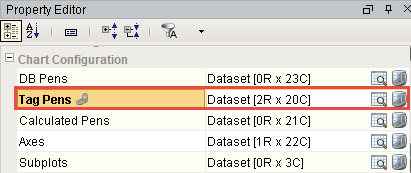
- Click the Cell Update binding type.
- Select Tag Path cell for the level_PV, and click on the green plus icon under the Cell Bindings Table.
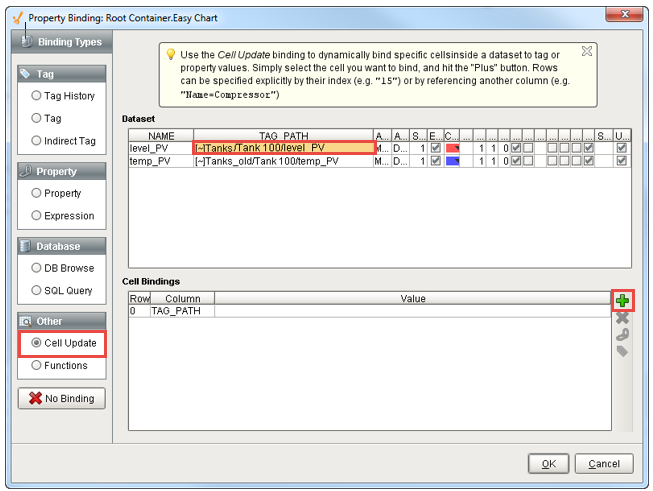
- Select the first row you just added in the Cell Bindings Table, and click the Link icon.
- From the Property Window under the Dropdown folder, click the Selected String Value. This will grab the Tank number the operator selected from the dropdown list. Click OK.
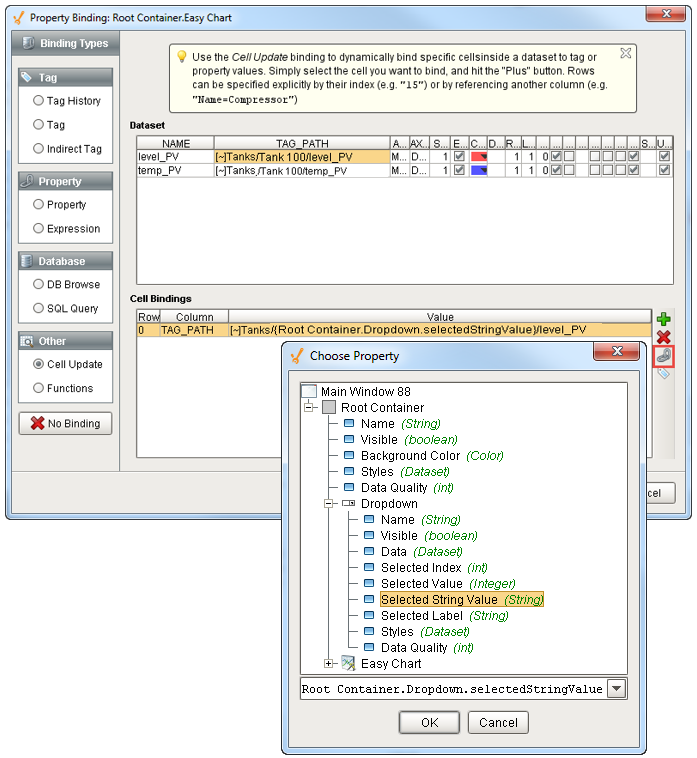
- Next, build out your Tag Path for the level_PV and temp_PV as shown below:
Cell Binding to make Tag Path Dynamic[~]Tanks/{Root Container.Dropdown.selectedStringValue}/level_PV
[~]Tanks/{Root Container.Dropdown.selectedStringValue}/temp_PV- Now, let's repeat the Steps i-vi for temp_PV. Select the temp_PV row under the Dataset Table, and click the green plus icon in the Cell Bindings Table to add a second row.
- You can cheat a little and copy the Tag_Path from the level_PV in the Cell Bindings Table and paste it in the second row for temp_PV. Delete level_PV and enter temp_PV.
- The Tag Paths for the level_PV and temp_PV are shown below. Click OK.
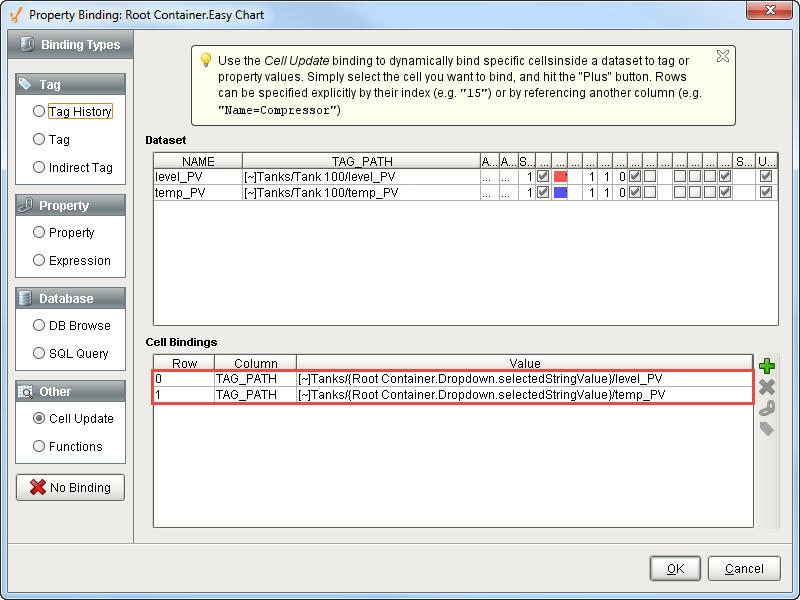
Now you have an Indirect Easy Chart. In Preview Mode, when an operator selects a different tank, the level_PV and temp_PV Tags will change. Select different tanks from your dropdown list and see how the history changes for the selected tank on the Easy Chart.
